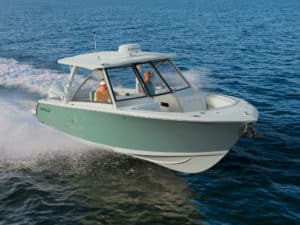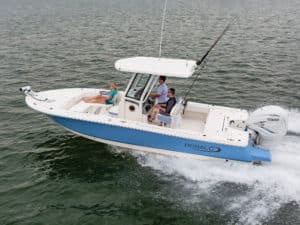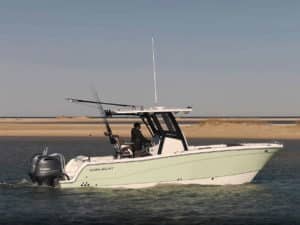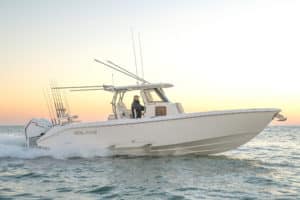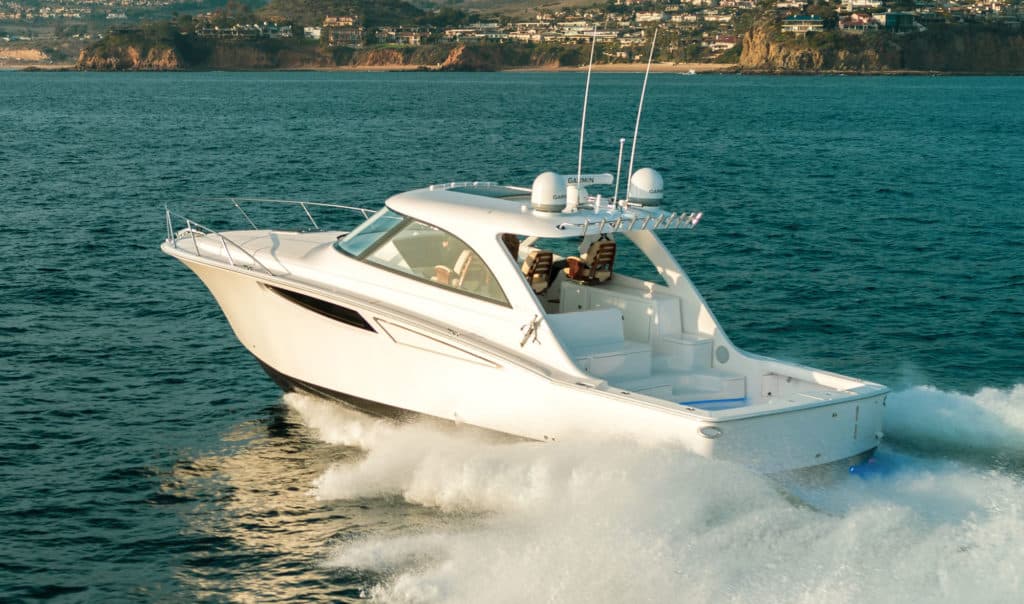
The DNA of Mag Bay Yachts’ new 42 dates back to the early 1990s. Though the company was started in 2014 by the father-son team of Mike and Barrett Howarth, they were also the family that founded the vaunted Cabo Yachts line of diesel-powered sportfishers in 1991.
Yet Mag Bay’s inaugural model, the 33 Center Console, bears little resemblance to a Cabo, leading the offshore sport-fishing world to believe that the Howarths had committed to the booming center-console segment. The 42 dispels that notion, as this new express-style sportfisher reflects much of the heritage of the original Cabo line. You could say that the Mag Bay DNA reflects a good amount of genetic diversity.
That made me all the more curious to climb aboard the 42, an opportunity that occurred as I joined Barrett Howarth for a test run of this model in the Pacific waters off of Newport Beach, California.
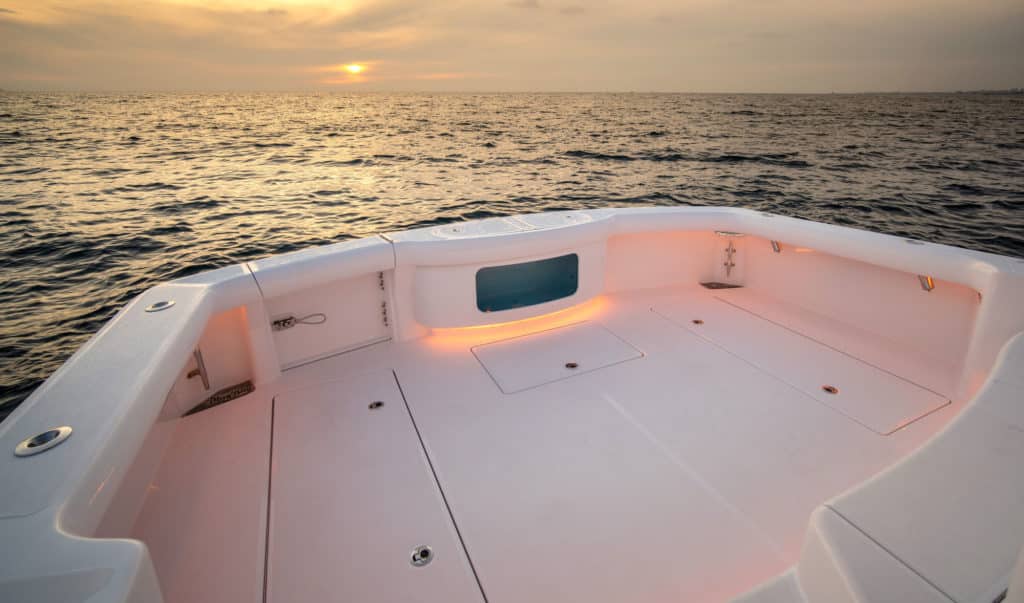
Boat of Details
“I call it a boat of details because we focus on building everything, even the smallest items, to the highest craftsmanship standards possible,” said Howarth, as we began our tour of the Mag Bay 42.
That became clearly evident as I examined details like the flawless bilge rigging, a specially designed compartment for the washdown spigots and shower hoses, and another that hides long-handled items such as deck brushes, boat hooks and gaffs.
Though teak covering boards and decking are available as part of the custom build process, my test boat featured an all-fiberglass cockpit. Smoothly rounded cockpit coamings are gentle on legs and help eliminate the need for padded bolsters. Diamond nonskid ensures traction on a wet deck, and below the cockpit sole, I discovered a pair of 70-gallon, guttered fish lockers.
In the middle of the transom resides an 80-gallon pressurized livewell with toe space below and a curved, aquarium-style viewing window. A beefy, outward opening tuna door in the starboard quarter lets you slide aboard big, heavy fish.
A three-step companionway leading to the helm deck splits the mezzanine seating in the forward cockpit. I found abundant dry storage under the seating, as well as below the elevated deck at the foot of the benches. The entire helm deck hinges upward at the push of a button to access the immaculate rigging in the engine room with its twin 1,000 hp Volvo Penta D-13 turbo-diesel inboards, Onan 13.5 kW generator, standard Seakeeper 6 gyro-stabilizer and other systems.
I measured 6 feet of headroom when I stepped down inside to get a sense of what it would be like to service the boat’s engines and ZF transmission.
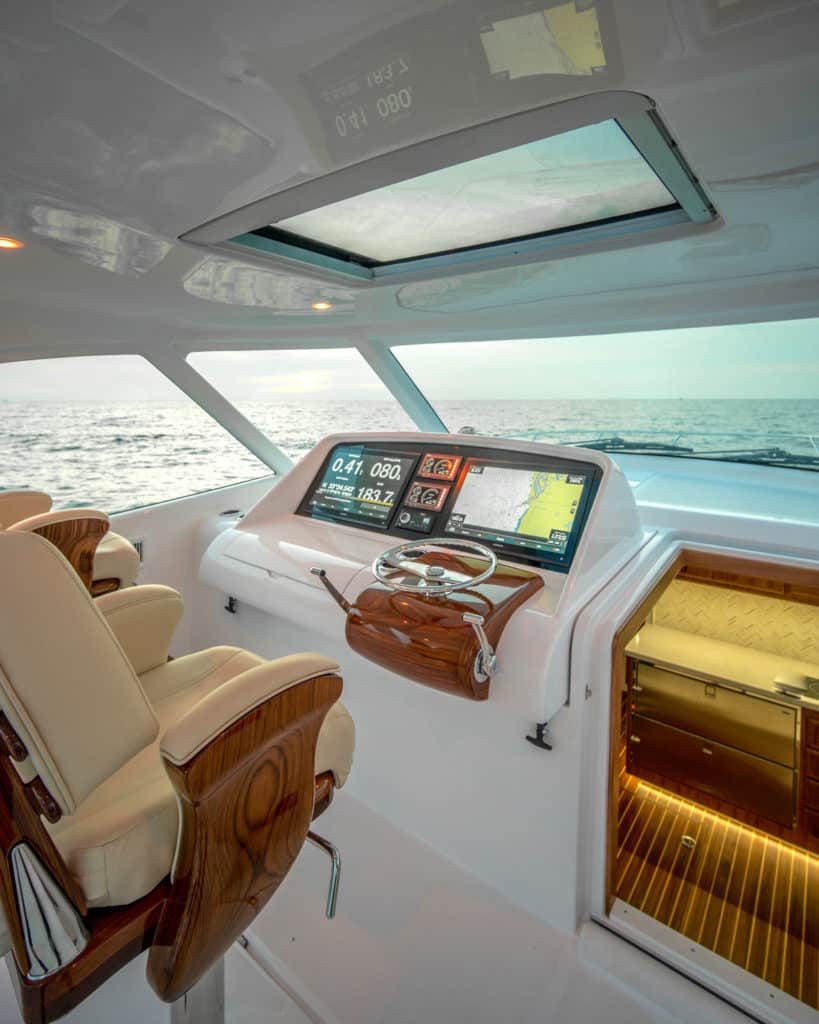
Two Versions
You can custom order the 42 as an open, sport express model or with an integrated hardtop, like the one I tested. Both versions feature wraparound glass windshields to protect the bridge deck, which features an L-shaped settee stretching across the aft bulkhead and extending forward on the port side.
The integral hardtop is supported entirely by the windshield-frame structure, with no supports for the portion that cantilevers aft, giving this top a sleek appearance. It also includes a retractable sunroof to usher in light and fresh air. My test boat also featured a rack of 10 rod holders lining the aft edge.
A tackle center with cabinets, drawers, spool racks, shelves and tackle boxes occupies the starboard side of the bridge deck. It also houses an icemaker.
The test boat’s expansive helm featured a pair of Garmin 24-inch multifunction touchscreen displays. A flip-open compartment to port conceals but allows immediate access to dedicated displays and controls for systems such as the Seakeeper, SidePower thruster joystick, autopilot, windlass and more. The entire dash module easily hinges upward if you need to inspect or service the rigging. A trio of adjustable helm seats cradles the captain and two companions in comfort.
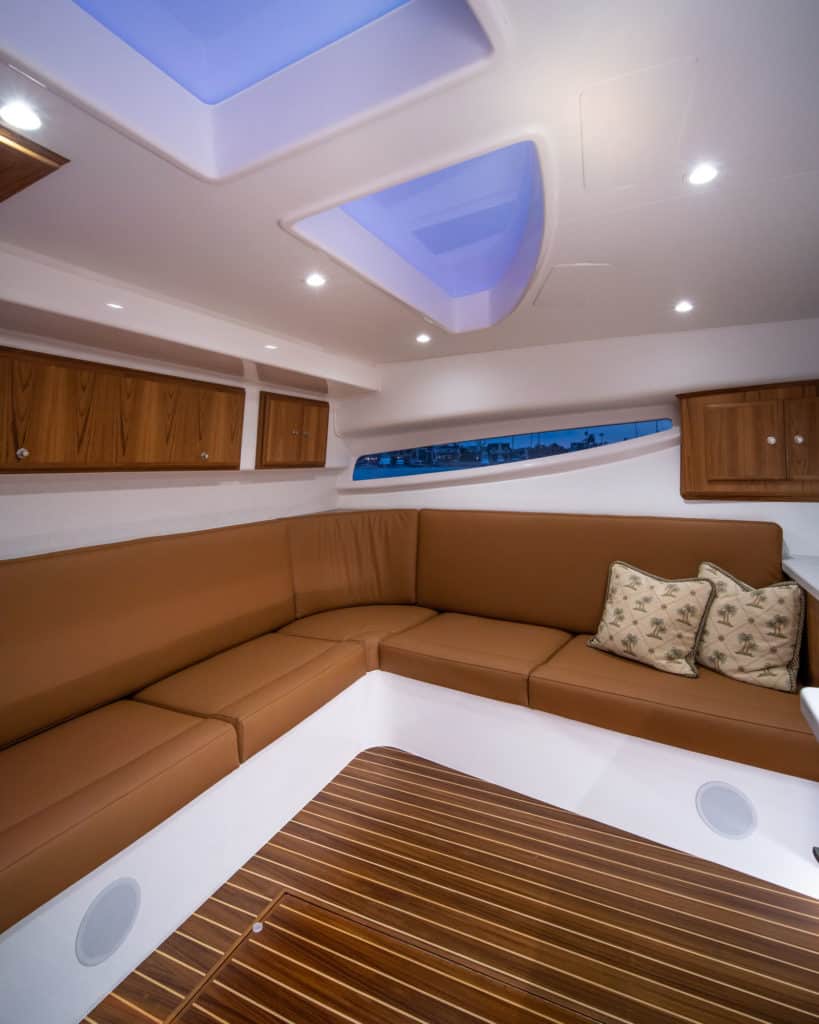
First Cabin
A pocket door on the starboard side of the bridge leads down to the salon and galley area, which offers 7 feet of headroom and a bright, airy feeling thanks to skylights and side windows, as well as overhead LED lighting. Wood cabinetry and decking lent a rich look to the quarters below deck on my test boat.
An L-shaped settee spans the aft bulkhead and port side, while the galley occupies the starboard area. It features a long granite countertop with tiled backsplash, cooktop and stainless-steel sink. Above is a microwave and below is a 190-cubic-inch Isotherm fridge/freezer.
The enclosed head is also to the starboard side, boasting 6 feet, 8 inches of headroom, a vanity and sink, standup shower and electric-flush commode. The salon also features a media locker for controlling the onboard audio system and other entertainment electronics.
Forward, through a central passageway, lies the master stateroom with a queen-size, elevated island berth, wood accents, overhead LEDs and a portlight hatch for illumination and fresh air. Teak cabinets above the berth store clothing items and other gear.
Accommodations belowdecks make the 42 a great boat for overnight trips, be it canyons in the Northeast, oil rigs in the upper Gulf of Mexico or multiday trips to the islands.
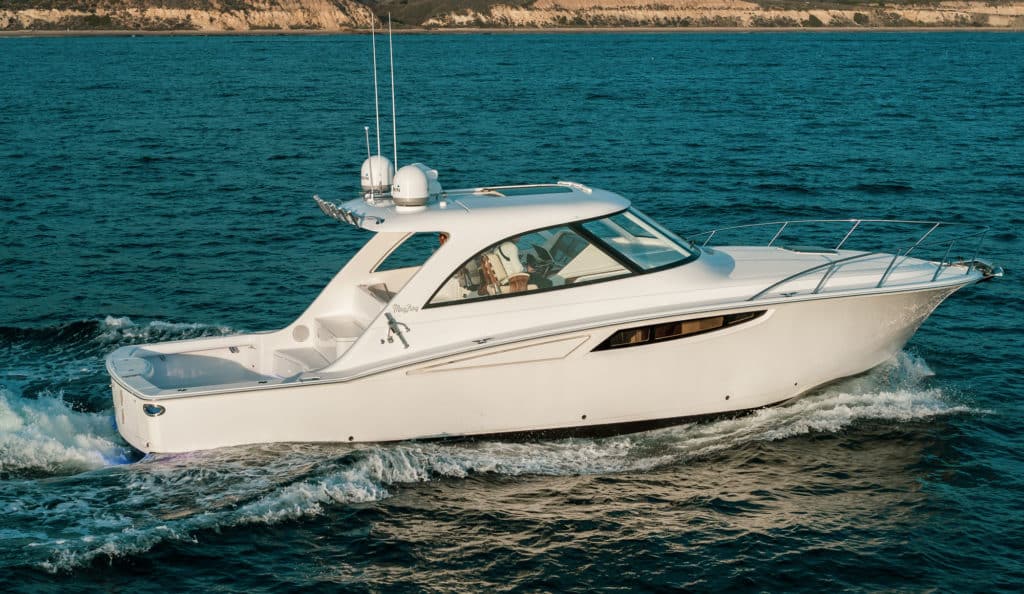
Performance
With 2,000 ponies pushing this 42,000-pound sportfisher, the Mag Bay 42 delivers plenty of get-up-and-go. You feel the power kick in 3 to 4 seconds after hammering the throttles as turbo-chargers spool up.
During my test, we jumped on plane in 9.5 seconds, and accelerated to 30 mph in 14.6 seconds. Top speed clocked in at 44.6 mph and 2,350 rpm, where the twin diesels burned 100 gallons per hour for 0.45 mpg. I recorded cruising fuel economy of 0.60 mpg at 1,900 rpm and 35.1 mph.
Trolling valves in the ZF transmissions let you reduce speed to as low as 2.6 mph for slow-trolling live bait. Without the trolling valves, the lowest trolling speed I could achieve was about 8.7 mph.
Read Next: Fish Trial: Mag Bay 33
The handling and seakeeping of the Michael Peters-designed hull proved nothing less than stellar. Though the water laid flat on test day, I attacked the wakes created by large boats in the area, and the 42 sliced smoothly through the mess. It cornered with confidence at speed, and the Optimus electro-hydraulic steering system eased the task of controlling the rudders.
At low speed, with judicial use of the throttle, I could easily spin the 42 within its own length. The Mag Bay backs down confidently and cleanly, and in the calm waters of my test, did not take a hint of green water over the transom.
Just as Cabo quickly ascended to the top, it appears that the same DNA will propel Mag Bay Yachts to angling prominence, as evidenced by the quality, fishing features and performance of the new 42.
Specifications
- LOA: 42 ft. 3 in.
- Beam: 15 ft. 6 in.
- Draft: 4 ft.
- Deadrise: 18 deg.
- Dry Weight: 42,000 lb. (w/ engines)
- Fuel: 700 gal.
- Max Power: 2,600 hp
- Base Price: $1,295,000
Performance
- Engines: Twin 1,000 hp Volvo Penta D-13 turbo-diesels
- Load: 665 gal. fuel, 130 gal. water, two crew
- Time to 30 mph: 14.6 sec.
- Top Speed: 44.6 mph @ 2,350 rpm
- Best MPG: 0.6 mpg @ 35.1 mph (1,900 rpm)
Notable Standard Features
- Michael Peters-designed running surface
- 80-gallon pressurized transom livewell with viewing window
- Seakeeper 6 gyro-stabilizer
- Three air conditioning systems (two for the bridge deck and one for the cabin)
- Zipwake interceptors
Mag Bay Yachts – Hesperia, California 949-395-0437

